Minerals found in Zimbabwe and verified deposits
Zimbabwe is blessed with rich mineral resource with every one of its districts having one or more minerals mining sector is highly diversified, with 63 different minerals listed on the table below. The major minerals include platinum group metals (PGM), chrome, gold, coal, lithium, and diamonds. The mining sector accounts for about 12 percent of the country’s gross domestic product (GDP) and 80 percent of national exports. The Chamber of Mines reported the mining industry generated $5.6 billion in 2022 compared to $5.1 billion in 2021, and it projected 10.4 percent sector growth in 2023.[1]
The country has the second-largest deposits of PGM and high-grade chromium ores in the world, with approximately 2.8 billion tons of PGM and 10 billion tons of chromium ore.
Mineral exports represent a significant portion of Zimbabwe's foreign currency earnings, with the Reserve Bank of Zimbabwe saying the mining industry accounts for 12% of GDP and nearly 70% of export earnings worth
The Minister of Mines had claimed the mining sector had the potential to generate $12 billion annually by 2023 if the government addressed challenges such as persistent power shortages, foreign currency shortages, and policy uncertainties. The Chamber of Mines reported the mining industry generated $5.6 billion in 2022 compared to $5.1 billion in 2021, and it projected 10.4 percent sector growth in 2023.
Mineral occurrences are distributed widely across the country with greenstone belts and the Great Dyke being host to most major minerals.
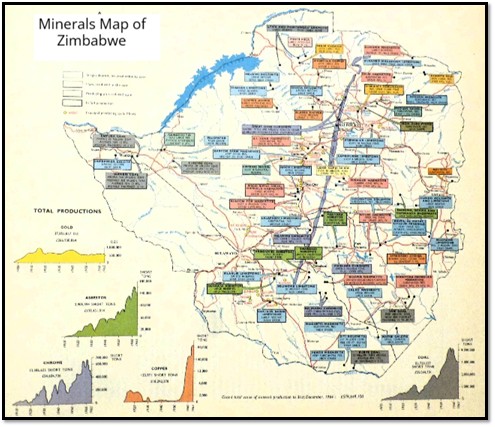
Source: Rhodesia: its Natural Resources and Economic Development.
Source: Mining Zimbabwe[2]
South Africa is the largest exporter due to its rich reserves of gold, manganese and platinum. Oil forms the bulk of Nigeria export earnings and the same is true of Algeria, Angola and Libya, although Angola also has diamonds and gold.
Egypt produces a variety of minerals including gold, copper and silver. Ghana also has gold, supplemented by limestone and iron ore. The Democratic Republic of Congo has rich resources of copper, cobalt and gold; an unstable political status inhibits mining activities. Gabon exports manganese, iron ore and uranium, as well as oil.
Zimbabwe’s main exports are listed below and the country occupies the tenth position in value of mineral exports. Sanctions against the ZANU-PF government and named individuals inhibits investor confidence and acts as a brake on mining development.
Zimbabwe mining in 2024 – an overview of minerals produced
Major minerals produced include gold, PGMs, diamonds, nickel, chrome, coal, lithium and black granite. Other minerals that the country is endowed with, but are not being produced, include asbestos, iron ore, tungsten, and graphite. Minor mineral endowments include phosphate, semi-precious stones (aquamarine, ruby, amethyst, emeralds), tantalite, manganese, vermiculite, limestone, and mica.
Zimbabwe has a long mining history has a stable mining law that provides robust security of tenure. The Mines and Minerals Act is the principal mining law, and this is supported by the Gold Trade Act, the Precious Stones Trade Act, the Minerals Marketing Corporation of Zimbabwe Act and various regulations that give effect to some provisions in the Acts.
The Ministry of Mines and Mining Development Administers the Mines and Minerals Act and is responsible for mining titles administration. The ministry has Provincial Offices in all the country’s provinces for purposes of issuance and administration of mining titles, except in the metropolitan provinces of Harare and Bulawayo. The ministry operates three technical departments that provide technical services and inspectorate functions. These are the Geological Survey, the Mining Engineering Department, and the Department of Metallurgy.
Zimbabwe also has an active small-scale mining industry that contributes significantly to the production of gold, chrome ore, tin, tantalite and semi-precious stones.[3]
Platinum Group Metals (PGM’s)
Platinum group metals are genetically associated with mafic and ultramafic rocks. In Zimbabwe, the main platinum reserve is found in the Great Dyke. It in exceptional characteristic of platinum is its catalytic activities, chemical inertness over a wide temperature range and high melting point. It is used as a catalyst to reduce the emission of carbon monoxide and hydrocarbons from light duty vehicle, catalyst in the manufacture of nitric acid.
PGM’s lead the mining sector although global prices for PGM’s including Platinum, Palladium and Rhodium dropped significantly in 2024. Major producers such as Mimosa, Unki and Zimplats have continued with their development plans, although they have been forced to cut production and some retrenchment has taken place to cut costs. Zimplats continues plans for a new smelter and new players, Karo Resources and Bravura have PGM projects at Mhondoro-Ngesi and Selous.
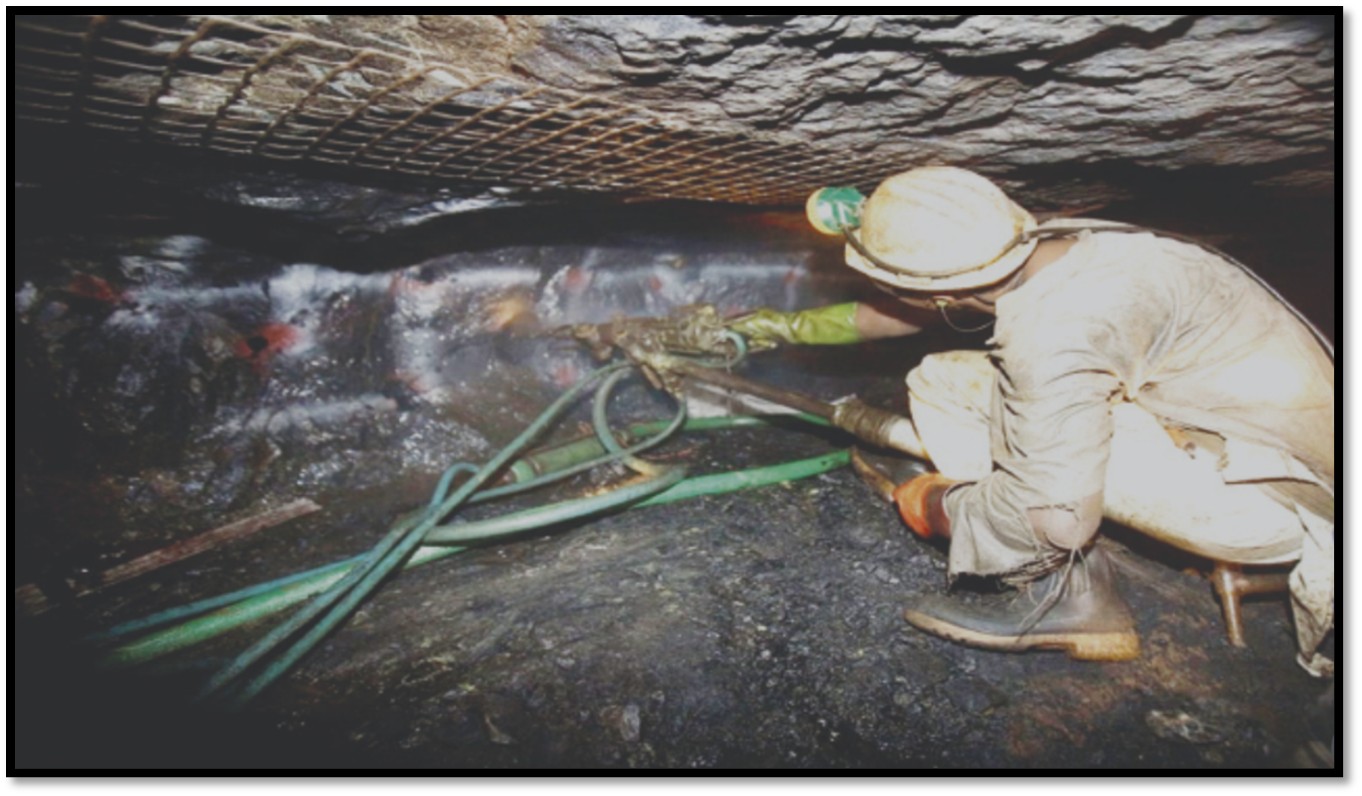
A miner inspects the platinum reef
Gold Zimbabwe's key economic driver
Gold remains important to the mining sector and as a foreign exchange earner. The government planned to reach US$4 billion in annual gold revenue as part of the US$12 billion mining plan by 2023. Although this goal remains unmet, Zimbabwe's gold deliveries to the Fidelity Gold Refinery (FGR) increased by over 7% in the first ten months of 2024 indicating a positive trend for the year.
Freda Rebecca gold mine, Shamva, and Jena mines, under Kuvimba Mining House, contribute around 10% of total gold deliveries to FGR. Other top producers include Blanket Mine in Matabeleland South, Rio Zimbabwe, Metallon Corporation, Sabi Gold Mine, Falcon Gold, Pickstone Peerless, Duration Gold Mine, Bilboes Holdings and Eureka Gold Mine. Kuvimba, Freda Rebecca and other mining firms are prioritising Environmental, Social and Governance (ESG) standards, including a gold traceability system to align with global best practices. This approach enhances the credibility of Zimbabwe's gold sector, attracting international investors.
In exploration, companies like Kuvimba Resources and Pambili Natural Resources are developing new gold projects, with Caledonia Mining Corporation implementing technological upgrades at Blanket Mine. These advancements boost production and operational efficiency. Kuvimba Mining House is also expanding production at Shamva Gold Mine, aiming to double output over the next few years.
The Chamber of Mines reported gold output reached an all-time high of 37.3 tonnes in 2022, up from 31.5 tonnes in 2021, and projected to increase to 42 tonnes in 2023.
Better Brands delivered 13 tonnes of gold to FGR in 2023, the highest volume in Zimbabwe and aims to increase this to 20 tonnes in future years.
There are a number of articles featuring the illicit gold trade fuelled by the country’s elite and the plight of artisanal miners on the website including:
- Zimbabwe’s illicit Gold Market hinders the country’s development
- Rushwaya gold-smuggling case exposes a microcosm of the corruption that exists in Zimbabwe today
- Oh dear, another foiled gold smuggling attempt is linked to the Zimbabwe President’s family
- Zimbabwe’s artisanal gold miners risk being poisoned with mercury (Hg)
- Zimbabwe’s artisanal miners, popularly known as makorokoza, risk their lives to make a decent living

An adit shaft of a gold small working
Lithium; now resurging in demand
Zimbabwe has been producing lithium over the last 60 years. Zimbabwe’s potential lithium reserves are the largest in Africa and sixth-largest in the world[4] and the Zimbabwe government has high hopes for lithium once the current projects are underway.
The demand for electric vehicles (EV’s) means lithium is required for their batteries and energy storage, this driving production for this mineral and Zimbabwe saw annual lithium revenue exceed US$0.5 billion with further growth anticipated.
One of the largest producers is Arcadia Lithium Mine owned by China’s Huayou Cobalt that produced over 200,000 tonnes of lithium concentrate in the eight months to August 2024. Potential output is projected at 450,000 and the mine should generate good profits with lithium prices between US$800-950 per tonne. Other major producers include Bikita Minerals, Sabu Star and new project construction from Bravura and Kamativi Mining Company.
It is estimated that over 11 Million tonnes of caesium – petalite resource exist at Bikita, making it the largest known such deposit in the world. Production at peak is about 50 000 tonnes per annum of LiO2.
Chrome production has also seen an uplift
The chrome ore resource, mostly along the Great Dyke, is categorised as world class, and considerable value adding takes place as the ore is processed into ferro-chrome alloys before export. There is scope for further value addition. Although there is a high demand for raw chrome in international markets, Zimbabwe has adopted a policy not to export raw chrome in order to encourage local beneficiation
The refurbishment of ZimAlloys high-carbon ferrochrome plant at Gweru and resumption of smelting operations has seen increasing interest in chrome mining with the company forecasting annual ferrochrome production of one hundred twenty thousand tonnes per annum.
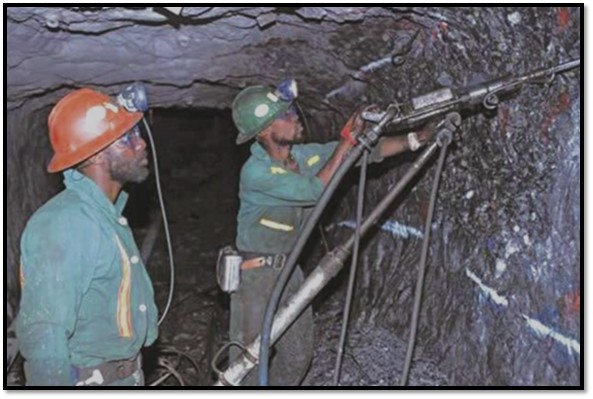
Miners drill shot holes prior to blasting
Coal production has revived
Coal has been the dominant energy mineral for Zimbabwe. The country boasts of vast reserves of coal particularly in the north-west and southern parts of the country. After almost collapsing the 121 year old HCCL Holdings, formerly Hwange Colliery Company Limited, has seen its fortunes reversed after restructuring its operations. Production has increased to four million tonnes and the company looks set to become profitable once again.
HCCL Holdings at Hwange is the only coal producing mine at present, has adequate capacity to meet the country’s needs in terms of energy requirements for domestic heating, agricultural heating, industrial energy as well as power stations. However, the quality of Wankie coal in terms of sulphur and phosphorous content is not suitable for metallurgical purposes and therefore such coal is imported mainly from South Africa. Other resources are being evaluated to determine viability of establishing a new power station to meet the country’s growing requirements.
Coal Bed Methane (CBM)
Coal-bed Methane: CBM recently discovered in the north-west of the country provides an alternative energy source to coal. The discoveries are considered to be comparable to those in the USA (according to Paul Tromp, an American who was involved in early exploration for CBM in Zimbabwe). Several exploration companies have reported viable resources awaiting further development and investment. This resource could be used for power generation, production of pharmaceuticals, ammonia-based fertilisers and other chemicals. Many downstream industries could be developed resulting in greater employment levels and a variety of new products.
Diamonds
After years of controversy and theft, diamond mining under Zimbabwe Consolidated Diamond Company (ZCDC) looks set for rising growth from 1,8 million carats to current annual production of 6 million carats and projected output of 10 million carats. The company states it is now concentrating on ESG standards to ensure ethical sourcing and sustainability.
The majority of the country’s diamonds come from its Marange diamond fields, an area of wide-spread small-scale diamond production in the Mutare district of Manicaland. See the article Marange Diamonds – Zimbabwe’s natural resource stolen from the nation under Manicaland on the website www.Zimfieldguide.com
The country has two other operating diamond mines, Murowa and River Ranch Mines, with the Marange resource still to be scientifically assessed to determine its full potential. The aeromagnetic survey of the area revealed exciting anomalies that indicate huge potential in green field diamond exploration.

Raw diamonds found at Marange diamond field, Manicaland
Iron Ore
The country has huge known iron ore reserves grading 40% Fe and above. Iron and steel production faced mixed fortunes in recent years. The challenges facing the steel works at ZISCO have impacted negatively on iron ore production. No iron ore production was realised in 2009. Priority currently lies in the rehabilitation of ZISCO as it will create upstream opportunities for iron ore production
Nickel
Among the base metals exploited in Zimbabwe, nickel dominates in terms of value. National production only peaked at 12 000 tonnes annually in 1999, but current production has fallen significantly largely due the adverse prices as well as the effects of retrogressive policies at play in the recent past. Production comes from several mines located on the greenstone belt and from PGM mining operations, as a by-product. With two operational nickel smelting and refining facilities, and favourable geological conditions for the existence of nickel deposits, investment into this area is encouraged. Nickel yields cobalt as a by-product.
Asbestos
Zimbabwe is home to long fibre asbestos, which has not been proven to be hazardous to human health. However, the blanket restriction placed on asbestos in certain markets in Europe and North America have thwarted the further development of production of this mineral in Zimbabwe. As more countries limit the use of asbestos products and the global market shrinks, competition for markets will be stiff. However, Zimbabwe has established a foothold in the Asian market and given the quality of the fibre produced, it is expected that there will be a sizeable market for Zimbabwean asbestos in the foreseeable future. Asbestos production for 2009 was about 5 000 tonnes compared to 250 000 tonnes produced in 1980. There are sufficient reserves to match the 1980 production for many years to come provided that capital is invested in this sector.
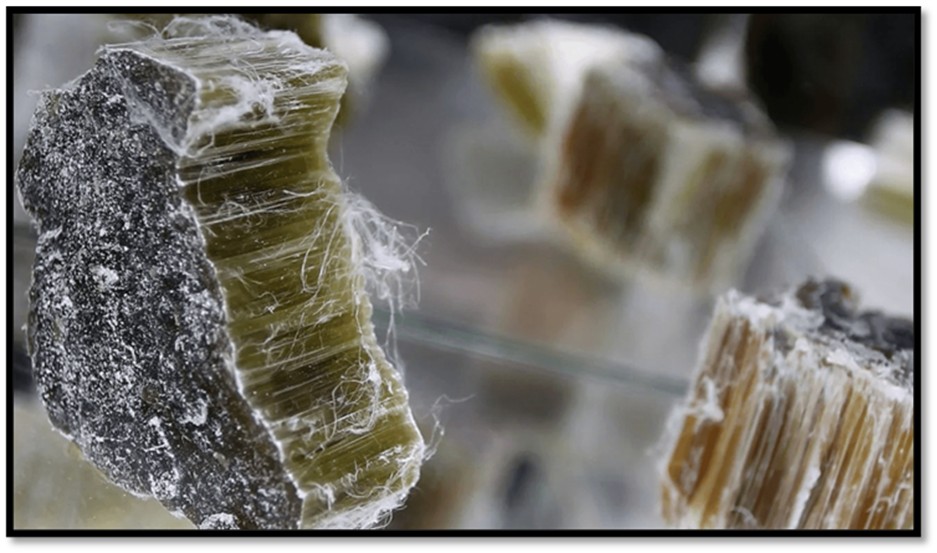
Asbestos in semi-processed state
Graphite
Graphite is produced at 1000 tonnes a month at Lynx Mine in the Northern part of the country. Lithium and Graphite are exported as raw products and could be with hardly any local demand require value addition locally and expansion of production base.
Black Granite
The distinctive Zimbabwe Black Granite is a much sought after dimension stone in the world. The resource is considerable and there is potential for investment by both local and foreign companies. Less than 10% of the total production is cut and polished locally, leaving a lot of room for investment in the value addition.
Silver
Most silver is produced as a byproduct of copper, gold, lead, and zinc refining.
Other Minerals
High volume low value minerals such as limestone, phosphate, iron pyrites and others are the backbone of local industries as they feed important domestic industries such as cement, fertiliser, paints and other industrial filers. There is an abundance of limestone to meet the country’s future needs. The country is yet to invest significantly in industrial minerals.
Despite the fact that the quantities produced are small, minerals such as kyanite, tantalite, magnesite, pyrites, clays, slates, phosphate, etc form the bulk of the large number of exploited minerals in Zimbabwe. These minerals can be developed at both large and small scales, and by both local and foreign investors.
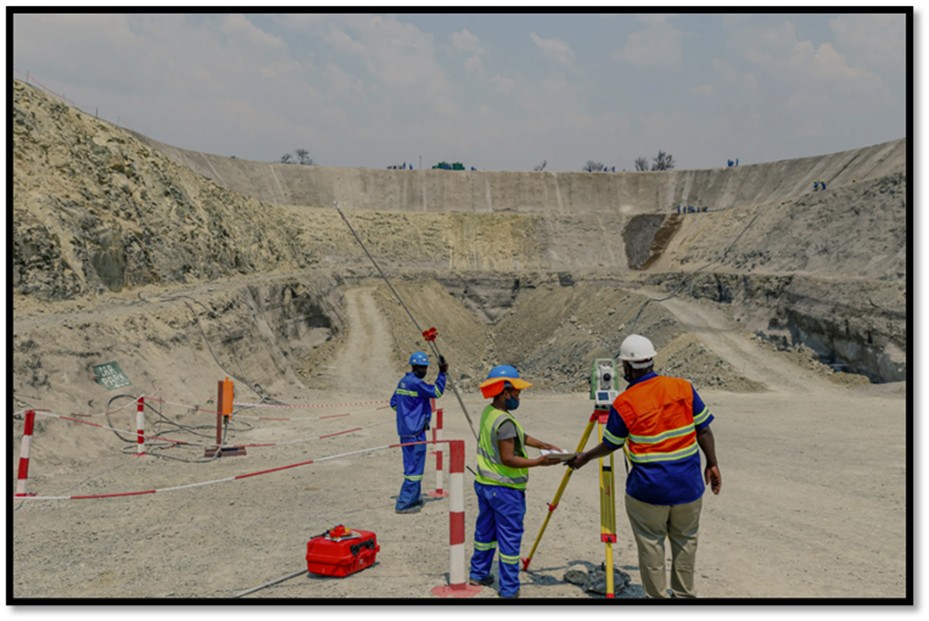
Mine Surveyors at work in an open-pit
| Minerals found in Zimbabwe | ||
| Agate | Chikomba, Lupane, Nyamandhlovu | |
| Aluminium | Mutare, Mwenezi, Nyanga | |
| Amazonite | Nyamandhlovu, Rushinga | |
| Amethyst | Hurungwe, Hwange, Lupane, Makonde, Nyamandhlovu | |
| Antimony | Bubi, Kadoma, Kwekwe, Mberengwa, Shurugwi | Antimony minerals, chiefly stibnite, is present in small amounts in many gold veins |
| Arsenic | Bubi, Gwanda, Mutare, Shurugwi | Arsenic, in the form of arsenopyrite, is found in many gold veins and extracted during gold processing and used as a cattle dip fluid |
| Asbestos | Insiza, Gwanda, Masvingo, Matobo, Mberengwa, Makonde, Umzingwane | Found within Serpentine bodies in the Great Dyke in zones from Filabusi through to Mberengwa (Belingwe) and Zvishavane (Shabani) to Mashava (Mashaba) including the Ethel and Gaths Mines |
| Aventurine | Beitbridge, Masvingo | |
| Barites | Kwekwe, Mwenezi | Barites is not common, but deposits occur near Shamva and Kwekwe (Que Que) and Masvingo (Fort Victoria) |
| Beryllium | Bikita, Bindura, Buhera, Chegutu, Gweru, Goromonzi, Gutu, Harare, Hurungwe, Hwange, Kariba, Marondera, Mberengwa, Mudzi, Mutoko, Rushinga | Beryllium is primarily found in pegmatite deposits. Locations include Sandawana Mines in Mberengwa, the Kamativi pegmatites in Matabeleland North, the Ubique deposit iat Hwange and Mt Darwin |
| Bismuth | Goromoni, Gwanda, Hwange, Insiza | |
| Cesium | Bikita, Goromonzi, Mudzi | |
| Calcite | Bindura, Chiredzi, Hwange, Mwenezi | Veins near Hwange (Wankie) in the northwest and Matibi in the Southeast have been exploited |
| Chromium | Chegutu, Chirumanzu, Guruve, Gwanda, Gweru, Insiza, Kadoma, Kwekwe, Makonde, Masvingo, Mberengwa, Shurugwe | Chrome occurs in Serpentine rocks in the basement schists of the Great Dyke at Shurugwi (Selukwe) Mberengwa (Belingwe) and Mashava (Mashaba) and at Mutorashanga (Mtoroshanga) in the north and Lalapanzi in the south. Ferrochrome was manufactured at Gweru (Gwelo) and Kwekwe (Que Que) |
| Citrine | Goromonzi, Harare, Marondera | |
| Clay | Bulawayo, Gwana, Gweru, Harare | Clay is widely distributed as small and large deposits |
| Coal | Beitbridge, Bikite, Binga, Chiredzi, Gokwe, Hurungwe, Hwange, Kariba, Lupane | Coal production started at Hwange (Wankie) in 1903 and still supplies coal, coke and by-products. Other coalfields are known to exist, but have not been developed |
| Cobalt | Bubi, Bindura, Insiza, Kwekwe, Shamva | |
| Copper | Beitbridge, Bikita, Bindura, Bubi, Bulawayo, Chegutu, Chipinge, Chiredzi, Chirumanzu, Chegutu, Gokwe, Gwanda, Harare, Hurungwe, Insiza, Kadoma, Kwekwe, Makonde, Masvingo, Mudzi, Mutare, Nkayi, Shamva, Shurugwe, | Like gold, also worked in prehistoric times and produced in the Save Valley (Umkondo Mine) Falcon Mine Mvuma (Umvuma) and the Chinoyi (Sinoia) area with Mangula, Alaska, Copper Queen and Copper King Mines |
| Cordierite | Beitbridge, Chimanimani, Hurungwe, Makuti, Rushinga | |
| Corundum | Beitbridge, Chiredzi, Goromonzi, Insiza, Makoni, Marondera, Mazowe, Mberengwa, Rushinga, Shurugwe, Wedza | Corundum is worked in a number of scattered locations |
| Diamond | Beitbridge, Bubi, Binga, Chivi, Gweru, Mutare, Mwenezi | |
| Diatomite | Hurungwe | |
| Dolomite | Beitbridge, Makonde, Masvingo, Mudzi, Mutare, Rushinga | This occurs at Diti near Beitbridge, Masvingo (Fort Victoria) Msukwi (Kariba) and Rusambo, east of Mt Darwin |
| Emerald | Gutu, Insiza, Hurungwe, Masvingo, Mberengwa | |
| Feldspar | Bikita, Goromonzi, Harare, Umzingwane | |
| Fireclay | Chiredzi, Hwange, Kadoma, Kwekwe, Lupane, Nkayi | |
| Flint Clay | Beitbridge, Mwenezi | |
| Flourite | Binga, Guruve, Hwange | There are deposits and past mining at the Tinde Flourspar Mine and the Marion Mine |
| Garnet | Beitbridge, Guruve, Hurungwe, Marondera, Mudzi, Rushinga | |
| Graphite | Hwange, Hurungwe, Kariba, Makonde | Good graphite deposits are present in the northern metamorphic belt near Miaami and Mt Darwin |
| Gypsum | Beitbridge | |
| Gold | Every district in Zimbabwe | Gold was worked extensively in this country from ancient times and still remains an important minerall export. The majority of gold mines have been small workings with only a few large gold mines, including the Cam and Motor, Dalny, Globe and Phoenix, Arcturus, Shamva and more recently Freda Rebecca, Blanket, Renco Mines |
| Iron | Buhera, Charter, Chiredzi, Gweru, Harare, Kadoma, Kwekwe, Masvingo, Mazowe, Mberengwa, | Iron ore of >50% is found in large deposits in the jasperlites and banded ironstones within the Basement Complex. Mining has occurred near Kwekwe (QueQue) at ZISCO (RISCO) and at Buhwa deposits (>60%) |
| Jade | Masvingo | |
| Kaolin | Bubi, Chegutu, Harare, Hwange, Kadoma, Kwekwe, Mazowe, Mutare, Nkayi, Umzingwane | |
| Kainite | Hurungwe, Mudzi, Nyanga, Rushinga | Good kainite deposits are present in the northern metamorphic belt near Miaami and Mt Darwin |
| Lead | Gokwe, Hwange, Kwekwe, Mberengwa, Mutare, Wedza | Large quantities of lead are present at Copper Queen Mine in the copper deposits and in the veins of in small quantities in gold veins |
| Limestone | Bindura, Chegutu, Chimanimani, Gwanda, Gweru, Harare, Hurungwe, Kadoma, Mazowe, Mberengwa, Mudzi, Shamva, Umzingwane | Large bodies of limestone are found around Zimbabwe and have been developed, largely for cement production, at Colleen Bawn, Lalapanzi, Kwekwe (Que Que) Chegutu (Hartley) and Harare (Salisbury) |
| Lithium | Bikita, Buhera, Chegutu, Goromonzi, Harare, Hwange, Insiza, Mutare, Mudzi, Mutoko, Rushinga, | Lithium ores including Lepidolite, Petalite, Spodumene and Amblygonitel have come in the past from the main Bikita pegmatite. Zimbabwe's production is steadily increasing with Sinomine Resource Group and Zhejiang Huayou Cobalt actively mining at Bikita and Arcadia. |
| Magnetite | Beitbridge, Buhera, Gwanda, Gweru, Insiza, Kadoma, Mberengwa, Mwenezi, Nyanga, | |
| Manganese | Gweru, Kwekwe, Makonde, Mberengwa | Manganese is a crucial element in steelmaking. Deposits have been worked at Kadoma (Gatooma) and Beitbridge and numerous small deposits exist |
| Mercury | Bubi, Kadoma | |
| Mica | Hurungwe, HwangwKariba, Rushinga | |
| Molybdenum | Chipinge, Gweru, Insiza, Kwekwe, Makonde, Mutare, Shurugwe | Several deposits are known |
| Mtorolite | Guruve, Mutare | |
| Nickel | Bubi, Bindura, Chegutu, Guruve, Gweru, Insiza, Kwekwe, Makonde, Matobo, Shamva, Shurugwi | Nickel has been exported from Trojan Nickel Mine at Bindura and Noel Mine near Bulawayo. Other deposits occur at Shangani Mine, and the Hunters Road Project and the Empress and Madziwa Great Dyke areas. |
| Ochre | Gweru, Kwekwe | |
| Palladium | Chegutu, Kwekwe, Makonde, Shurugwi | |
| Phosphate | Buhera | Phosphates occur as large deposits in three carbonate ring complexes southwest of Mutare (Umtali) at Dorowa, Shawa and Chishanya and is converted into fertiliser |
| Platinum | Chegutu, Centenary, Kwekwe, Makonde, Shurugwe | Platinum exists in large tonnages in the Great Dyke, the world's second largest reserves and is mined at Unki Platinum Mine, Zimplats, Mimosa and Karo Resouces |
| Pyrite | Bulilimamangwe, Gwanda, Hwange, Kadoma, Mazowe, Shamva, Shurugwe | Deposits containing >40% sulphur in banded ironstone are mined at Mazowe (Mazoe) and converted into Sulphuris Acid at Harare (Salisbury) |
| Salt | Mwenezi | |
| Sapphire | Mudzi | |
| Selenium | Makonde | |
| Silica | Chegutu, Gweru, Gokwe, Goromonzi, Harare, Kwekwe, Makonde | Silica sand is used in a number of industrial applications including glass manufacture, abrasives, foundries and municipal water purification |
| Sillimanite | Hurungwe | |
| Silver | Kwekwe, Makonde, Makoni, | |
| Talc | Bubi, Goromonzi, Guruve, Insiza, Kwekwe, Makoni, Mberengwa, Mt Darwin, Mutare, Mutoko, Nyanga, Wedza | |
| Tantalum | Bindura, Bikita, Buhera, Chimanimani, Chivu, Guruve, Goromonzi, Gutu, Harare, Hurungwe, Hwange, Insiza, Kariba, Makoni, Marondera, Mazowe, Masvingo, Mberengwa, Mt Darwin, Mudzi, Murehwa, Mutare, Mutoko, Rushinga, Shamva, | Tantalite are found in pegmatites throughout the country, but the biggest producer in the past was the Benson Mine at Mutoko (Mtoko) |
| Tin | Bindura, Bikita, Goromonzi, Gutu, Harare, Hurungwe, Hwange, Masvingo, Mt Darwin, Mudzi, Mutare, Nyanga, Rushinga, Shamva, | Small quantities occur in pegmatites with major production from deposits of cassiterite at Kamativi in Matabeleland North |
| Topaz | Gweru, Hurungwe, Mutare | |
| Tungsten | Bindura, Bikita, Bubi, Buhera, Bulawayo, Chegutu, Chipinge, Chiedzi, Goromonzi, Guruve, Gwanda, Gweru, Harare, Hurungwe, Hwange, Insiza, Kadoma, Kariba, Kwekwe, Makoni, Matobo, Mazowe, Masvingo, Mberengwa, Mt Darwin, Mudzi, Mutare, Rushinga, Shamva, Shurugwe, Umzingwane, Wedza | Tungsten in the form of scheelite and wolfram occurs in veins in or near the gold belts and has been mined in pockets |
| Vanadium | Bulawayo, Guruve, Mt Darwin | |
| Vermiculite | Buhera, Mudzi | |
| Zinc | Gokwe, Kwekwe, Nyanga | Large quantities of zinc are present at Copper Queen Mine in the copper deposits and in the veins of in small quantities in gold veins |
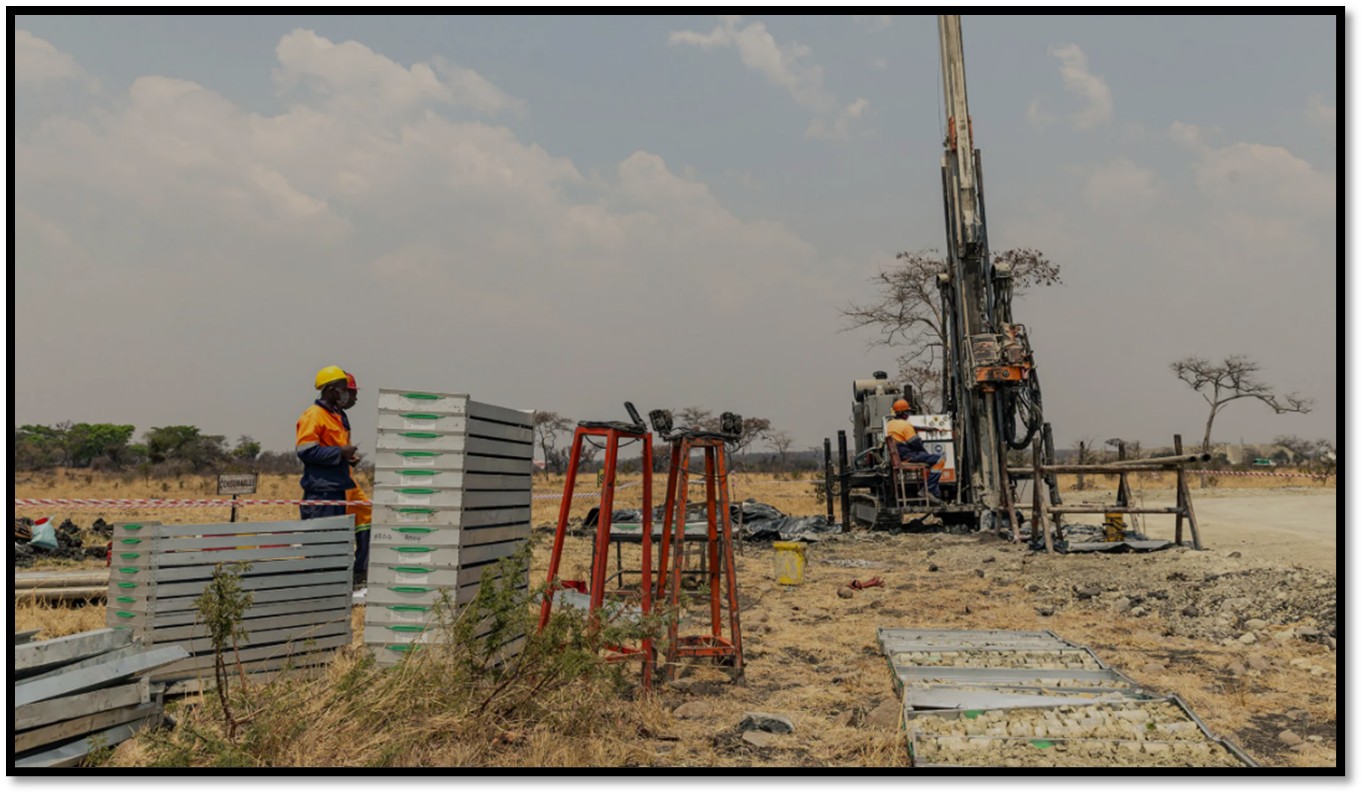
Drilling teams carrying out exploration work to assess a mineral deposit
Challenges
Government policies have cast a long and deeply negative shadow over the mining industry in the past.
The inability to retain all of their foreign currency earnings have really challenged mineral exporters, particularly when the parallel-market exchange rate departed from the official rate, leading to wide-spread smuggling. Previously to foreign exchange retention was 60%; in February 2023 it increased to 75%. This is a heavy cost particularly when many of the mining inputs such a capital equipment and chemicals and even local electricity have to be paid in foreign exchange.
The current Mines and Minerals Act dates back to 1961 and is considered outdated. The Zimbabwean government has been working on revising the Mines and Minerals Act (1961) for over a decade to make it more investor-friendly and align it with modern ESG standards, but the bill has faced delays and hasn't been finalized. A key reason for the delay has been disagreements among stakeholders and constitutional hurdles including transparency in title allocation and community benefits. In 2023, a revised bill was proposed, but it was not approved before the Ninth Parliament dissolved.[5]
Mining companies are required by law to export all minerals through the state-owned Minerals Marketing Corporation of Zimbabwe (MMCZ) The only exemption is gold that has to be sold to the Reserve Bank of Zimbabwe (RBZ) through its subsidiary Fidelity Printers and Refiners (FPR) On an individual basis subject to government approval mining companies may sell minerals directly to foreign buyers directly to avoid US targeted sanctions against the MMCZ.
Other challenges include known smuggling, especially gold of an estimated US$1.9 billion in the artisanal mining sector, fuel and electricity shortages and antiquated technology persist. The FPR hopes that direct payments to artisanal miners will stem the flow of gold smuggling, but critics claim that unless the price matches the prevailing gold price, efforts will fail.
Opportunities
Zimbabwe’s government understands that much of the country’s minerals are currently exported in unprocessed or semi-processed form and wishes to increase the domestic production of value-added minerals. However they understand this requires a much greater investment in capital equipment and technology and a better business environment for foreign investors.
Zimbabwe mineral production from 2011-2022
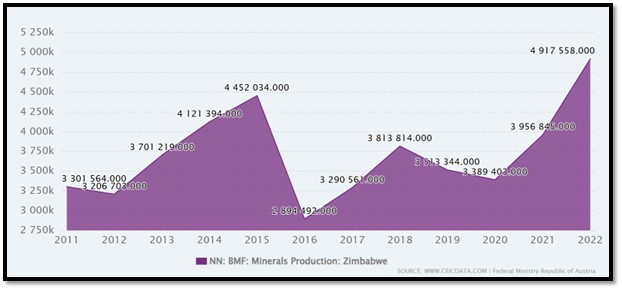
Source : www.ceicdata.com/en/indicator/zimbabwe/minerals-production
References
M.O. Collins. Rhodesia: its Natural Resources and Economic Development. Mardon Printers, Salisbury. 1965
Mining Zimbabwe. 29 May 2023. Zimbabwe ranks tenth African country with booming mineral exports. https://miningzimbabwe.com/zimbabwe-ranks-top-10-in-africa-with-booming-mineral-exports/
Mining Zimbabwe. Minerals found in Zimbabwe and verified deposits. 26 Mar 2020
/https://miningzimbabwe.com/minerals-and-locations-found-in-zimbabwe/
R. Mapuranga. Mining Zimbabwe. Zimbabwe Mining in 2024 – a quick overview. 20 Dec 2024.
https://miningzimbabwe.com/zimbabwe-mining-in-2024-a-quick-overview/
USA International Trade Commission. Zimbabwe Country Commercial Guide. 29 Feb 2024. https://www.trade.gov/country-commercial-guides/zimbabwe-mining-and-minerals#:~:text=The%20Chamber%20of%20Mines%20reported,percent%20sector%20growth%20in%202023
Federal Ministry Republic of Austria. CEIC data. Zimbabwe Minerals Production. https://www.ceicdata.com/en/indicator/zimbabwe/minerals-production
Chamber of Mines of Zimbabwe. https://www.chamines.co.zw/home/overview
